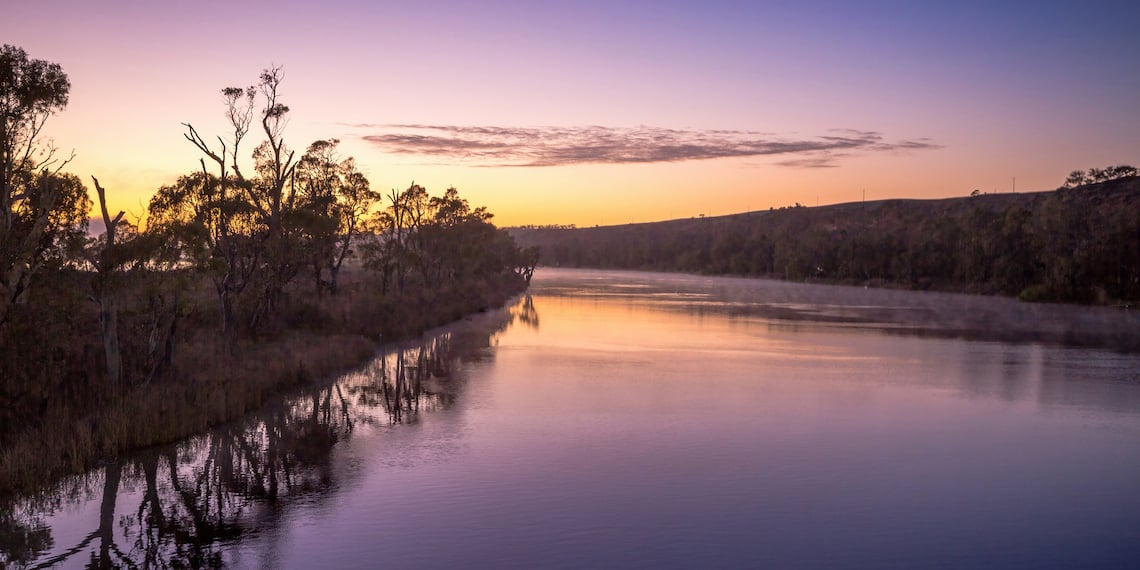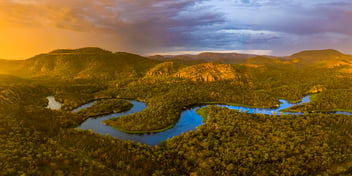Applying cultural archaeological insight to contemporary water management issues

Contemporary water management practice has a lot to learn from Aboriginal cultures, as well as insights gained from exploring how people lived on Country in the past, according to community-based archaeologist and Ngarrindjeri person Dr Chris Wilson.
“In archaeology, we define things based on geological periods. Mainly because that’s the way western knowledge systems have divided up space, place and time. But my approach to community-based archaeology attempts to tell a bigger story,” he said.
“That’s very much the type of work I like to do; it’s based on the ground, working with the community. It’s not about the oldest date, or the most magnificent site, but more about how this information can help us find solutions for today by investigating the past.”
Wilson recently led a collaborative research project applying radiocarbon dating of various species to confirm freshwater riverine and lacustrine conditions within the lower River Murray throughout the Holocene – an insight that has big implications for current debates around the original natural conditions of the river system.
The research was conducted as part of the Lower Murray River Irrigation project, which was supported by the Ngarrindjeri Regional Authority and involved consultation with Grant Rigney, Professor Daryle Rigney and Associate Professor Steve Hemming.
Wilson said this project was instigated following earlier archaeological research into burial sites along the lower Murray, showcasing how understanding life in the past, coupled with cultural knowledge, can lead to deeper insights into how to manage water-related issues.
“I started out in the early 2000s on a lower Murray Irrigation Area project. It was responding to drought and the visibility of archaeological burial sites that were being exposed along the river Murray,” he said.
“I worked with the Ngarrindjeri community as part of my archaeological training at Flinders University around the repatriation of human remains. And this project focused on community cultural heritage management ended up providing important insight for water issues.”
Part of this research involved analysing around 100 shell middens – distinct concentrations of shell containing archaeological evidence of Indigenous cultural activities.
“There were a lot of burials in the area, which is where my research started. And a lot of the shell middens were burial places. They act as marker in the landscape, they signify territories and peoples relationship to Country,” he said.
“Understanding how people lived in that landscape helps to provide another perspective. I believe the role of the archaeologist is not just about describing the cultural material, it’s also about developing the story around it.”
Wilson said this is why working with the community is really important.
“I’ve tried to document some of that community insight, and really bring to light that there’s archaeological knowledge, but also Indigenous knowledge, as well,” he said.
“I use my own lived-experience as a Ngarrindjeri person working with my own community to develop that story.”
Archaeology meets water
Following the completion of his PhD in 2007, Wilson said it became apparent that the cultural archaeological insight he’d been producing was going to be very useful for water and environmental management.
“We started the most recent project looking at past conditions in the lower Murray as a collaboration. There are so many different areas of expertise required for these investigations, so collaboration is really important,” he said.
“One of the big debates that we were all connected to was around what period our current sea levels stabilised. Sea level change is thought to have happened around the mid-Holocene – the period when it's thought that major changes happened in our most recent global formation of our rivers and coastlines.
“These are the current underlying assumptions and theories. But understanding when the water levels around the lower Murray mouth and connected lakes stabilised helps us to determine the best water management practices for today.”
Wilson said one of the key considerations in the region is whether or not saltwater came all the way up the river, or if original natural conditions were more of a hybrid salt and freshwater environment.
“Some researchers were suggesting that saltwater came all the way up the river. But we were not seeing that in the archaeology, because there are no saltwater mussels in the shell middens,” he said.
“But we know that was the main source of food in that area, the main economy for past peoples. If mussels are their primary economic resource, then you’d expect to see them.”
Radiocarbon dating of Aboriginal middens adjacent to the river and lakes comprising freshwater mussels, crayfish, turtles and otoliths of freshwater fish species, such as Murray cod, confirm freshwater riverine and lacustrine conditions throughout the Holocene.
“We are still trying to find answers to some of these questions, which is quite surprising considering all the technology and knowledges we have available today. But now people are turning to Indigenous knowledges, too,” Wilson said.
“This sort of research helps us explore how Indigenous knowledge and culture can bring a deeper understanding of some of the water and environmental management issues facing our modern society.”
Wilson said another important insight revealed from the study of Murray cod otoliths was a direct correlation between archaeological evidence and Aboriginal knowledges.
“Indigenous knowledge isn't necessarily available to the public, but some describe certain species of fish and sharks, coming up the river, and the Murray cod is connected to creation stories,” he said.
“The recent research by Morgan Disspain looked at the lifecycle of the Murray cod otoliths excavated in the lower Murray. She found that those fish ear histories showed the river changed its salinity level throughout the year.”
Wilson said this confirms what Aboriginal people have been observing in the environment for a long time.
“It shows that some fish that we think of as freshwater could have actually been spawned in saltwater environments, and moved throughout those different environments,” he said.
Passing it on
Wilson said telling the bigger story of how people lived along the lower Murray in the past opens up to further explorations about how water and the environment works, but it starts with ensuring these projects are connected to the community.
“We need to steer back, and have a better relationship with Country and our local communities, and value our land differently,” he said.
“And certainly, there are places where we don’t see water, but it’s there. There are a lot of misconceptions about how things flow, where water is and how our environments work. We need to pass this information onto the next generation.
“That’s what Indigenous mob do. We are very focused on passing information onto the next generation so that they can care for Country. And I think there is a lot to learn from those practices that help compliment all the other science and research that we do.”

